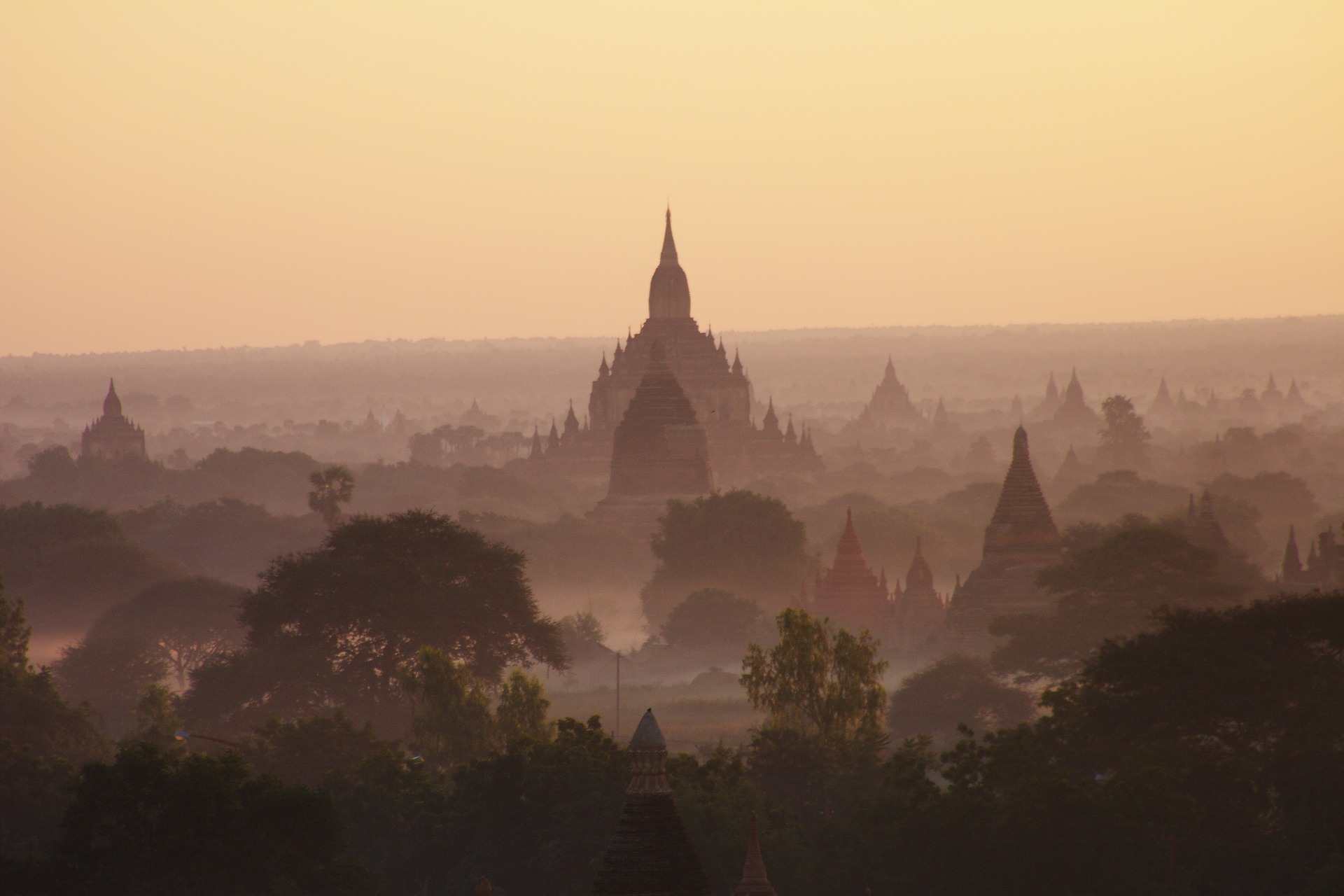Cruise Myanmar’s meandering Irrawaddy River on the Belmond Road to Mandalay to blend luxury with discovery in one of Southeast Asia’s most unforgettable destinations discovers Nick Walton.
It’s midday, and on the banks of the mighty Irrawaddy, women, and children from the nearby village of Taung Be wash clothes and bathe in the river’s swirling waters. They wave and smile as we approach and clamber aboard a rickety longboat, its paint faded from countless Burmese summers, for the quick passage out to the ship. Across the river, the sun glistens off the tips of countless gilded stupas and the air is alive with insects and birdsong.
READ: This New Point n Shoot Just Loves Taking Video
The Road to Mandalay, Belmond’s pioneering river journey through Myanmar, is by far the best way to explore this once closed and still emerging country. From the temples of Bagan to the monasteries and markets of Mandalay, passengers on the Road to Mandalay are exposed to a stunning cross-section of the country’s past and present, while contributing to its ever hopeful future.
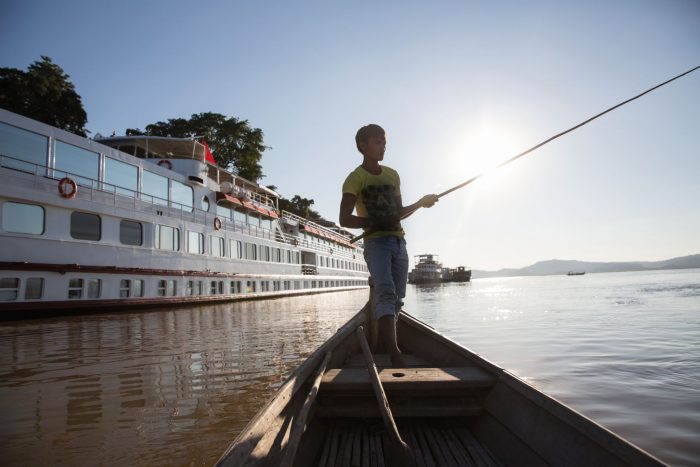
Myanmar, formerly Burma, is a truly unique destination; it’s yet to welcome mass tourism and seems, in many ways, blessedly trapped in the past. But with the end of military rule and the first elections in two decades (as dubious as they might have been), Myanmar is taking tentative steps towards modernity.
We had flown into Bagan from the capital Yangon, after a night at Belmond’s Governor’s Residence, a charming, colonial-esque boutique hotel nestled in the heart of the city’s leafy embassy district. Once landed, we quickly made our way by bus to the riverside.
READ: We Explore Cambodia’s Tonle Sap Lake With Aqua Expeditions
Belmond’s team looks after everything, from getting through Myanmar’s rather bureaucratic immigration process to money changing (once the bane of every Burma-bound traveler) and paying the countless little fees at every stop along the route. They have a long relationship with the country and its people, and it’s now paying dividends.
The river’s silty waters swirl around the ship; in low season the current is a steady three knots, which gives the impression the Road to Mandalay is sailing at full pelt upstream. The Captain later tells me that in the height of the rainy season, that current can increase to a torrential six knots.
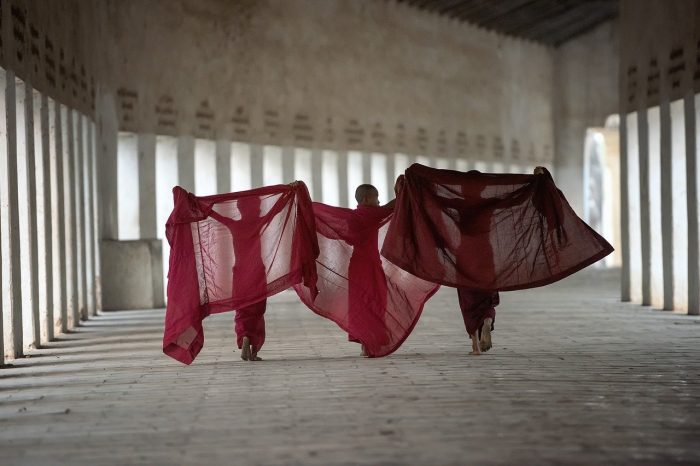
The Road to Mandalay, once a German river cruiser, was the first international luxury vessel to ply the waters of the Irrawaddy and is regularly and lovingly renovated to ensure she stays as grand as she was on those pioneering first jaunts upstream. Our stateroom, one of the ship’s Governor’s Suites, is spacious and bathed in sunlight from two double-height windows. The vessel boasts spacious cabins and lounges, a formal dining room, and a sun-drenched pool deck.
Bagan is an ancient capital situated on the dry central plains of Myanmar, some 90km north of Mandalay, and is best known for its fields of temples – more than 2,500 of them. Flying into Bagan, the ground is ablaze with flashes of gold as the sunlight strikes the more modern gold-leafed temples, but it’s not until you’re on the ground, driving down dirt tracks and past lines of saffron-robed monks holding black lacquer alms bowls, that you realize just how many shrines there really are. The horizon is dotted with temple tips, from gold leaf to a reddish hue fashioned from local clay bricks and glazed by countless summers under the hot Burmese sun.
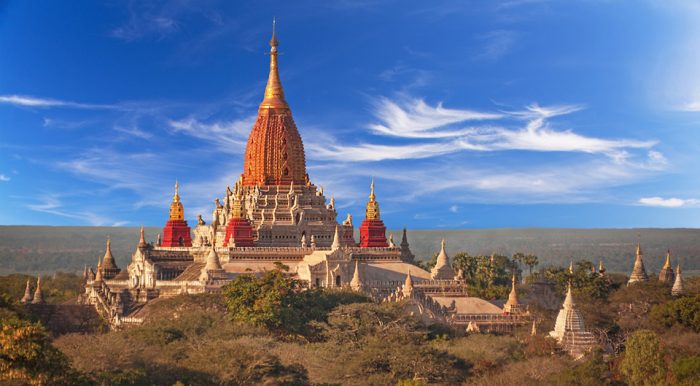
We make the most of our time in Bagan and visit the acclaimed Ananda Temple, a Buddhist sanctuary built in 1105AD. One of four remaining ancient temples in Bagan (we quickly learn the subtle differences between stupa, pagoda, and temple), it’s laid out in a cruciform, with a small, circular pagoda on top, covered in an umbrella-like hti. The four towering gold Buddha statues within are astounding; each beaming statue was crafted from a single piece of teak and is a staggering nine meters tall.
The statues seem to glow, their golden exteriors reflecting the little light that seeps into the interior of the temple. Children play hid and seek in the shrine’s nooks and crannies, their giggles cascading off ancient whitewashed walls studded with smaller, more modest shrines.
READ: This Airline’s Business Class Just Might Be the World’s Best
Down dirt paths and through tiny villages where children play in the long grass and men lead carts pulled by white bullocks, we come to an emerald green field of maize and temple tops. Following a well-worn path that winds through the shade of sun-bleached trees, we discover the base of a crumbling, box-shaped monastery, dating from the 12th century. It’s easy to see the poverty that monks endured for their faith; tiny stone rooms branch off the main hallway with such a low ceiling that it’s
impossible to stand up straight. Following the flashlight beam of our trilingual guide, Kit, we clamber up through incredibly narrow staircases to the rooftop, from which the true majesty of Bagan can be seen. For as far as the eye can cast, there are the spires of temples, pagodas, and stupas, some standing proud, others slowly being reclaimed by the earth.
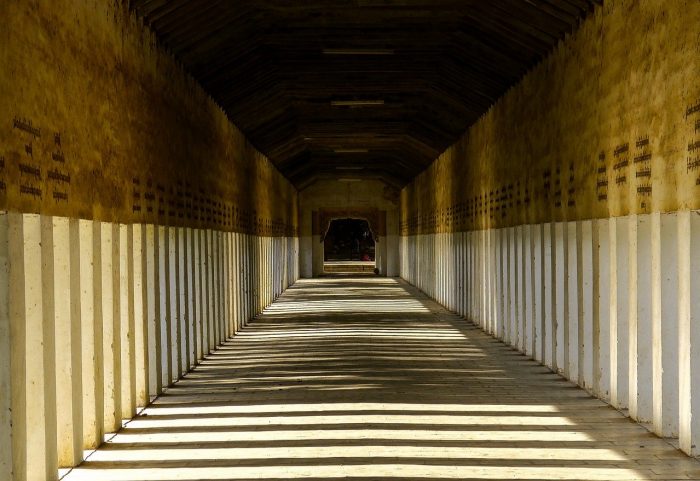
After watching the sunset from nearby Shwesandaw Paya, also known as the Sunset Pagoda, we encounter a village celebrating its ‘temple day’, an annual festival that includes efforts to clean and mend the local pagodas, as well as plenty of loud music, performances, and even fireworks. We walk through the village, snacking on ceremonial cookies made from caramelized brown sugar and rice, and watch young novice monks scurry behind trucks carrying performers to the stage. In front of the temple, hundreds of wooden beds are laid out – this is an all-night affair and the party is only just getting started as day turns to night.
Back on the ship, it’s time for cold towels, and cocktails on the pool deck before a quick change and dinner in the main dining room. It’s this contrast that makes the Road to Mandalay such a popular option; you can explore temples all day, like a regular Indiana Jones, and yet dine like you’re in one of the best restaurants back home, complete with an extensive wine list and cigars afterward, under a canopy of stars.
READ: This Aussie Outback Hideaway is About As Wild As it Gets
The next morning, after a leisurely breakfast, Kit leads us to the Shwezigon Pagoda, certainly one of Bagan’s most spectacular. Aglow in the early morning light, its 98-meter golden stupa is stunningly beautiful, and the scene is set with the chants of young monks learning Buddha’s scripture by heart. In the shade of the temple’s buildings, old women chuff away on massive homemade cigars made from Say Ywat Kyi leaves, while others chew betel nut and laugh with ghoulish red smiles.
In the local markets of Nyaung-Oo, women sit on sackcloth and sell freshly-picked vegetables. There are exotic fruit and strange roots, hand-made puppets, and hand-crafted longi sarongs. An old man shades himself under a tree and plays a saung, an ancient harp-like instrument, its delicate notes drifting over the commerce below.
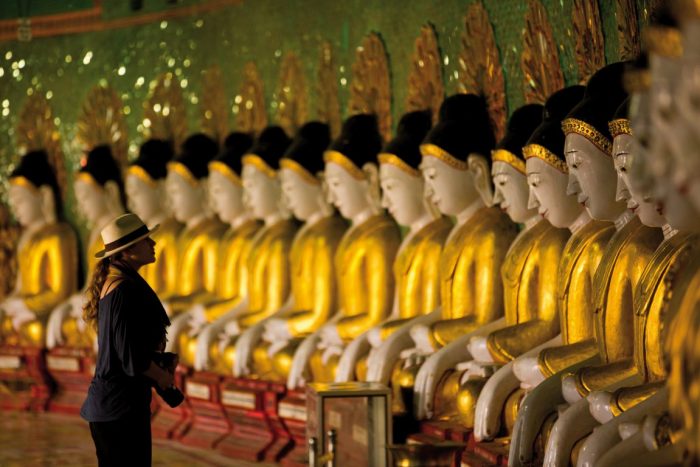
We’re sailing north towards Mandalay by noon. Guests migrate to the sun-drenched pool deck for alfresco lunches, cooking demonstrations, and dips in the deep swimming pool. Beyond, river life slips by; fishermen look up from their nets and wave as the ship passes, and on the dusty river banks, lines of village women, fresh produce balanced on their heads, can be seen walking to market. The glowing tips of temples can be spied many kilometers before we pass them.
We spend the next day steaming downriver, watching bridges and highways grow on both sides of the river, and waving to villagers assembled on the river banks, arriving just outside Mandalay, at the ship’s homeport of Shwe Kyet Yet, in the afternoon. The ship passes under two towering bridges, from which children wave, and then docks under a hilltop encrusted with pagodas dressed in ivory and gold.
READ: Ever Wondered What it’s Like To Ride Russia’s Regal Rails?
In nearby Amarapura, another of Burma’s former royal capitals, we watch women, their faces coated in thanaka, a yellowish paste made from the bark of the wood apple tree, produce brightly colored fabric on ancient timber looms. In the marble carving neighborhood, spotless white Buddhas are born, chiseled by the men, then delicately bathed by the women. We watch shirtless teenage boys use hammers and durable bamboo paper to beat gold nuggets into leaf, while women sit in a cool room beyond nimbly portioning out the wafer-thin pieces for purchase by Buddhist pilgrims.
At the Kuthodaw Pagoda, a local television company is filming a romance story among the temple’s 792 kyauksa gu, little white shrines, each housing a marble slab inscribed with text from the Tipitaka, Buddhist scripture. Elderly monks ignore the crowds coming to see some of Burma’s most famous stars. Instead, they focus on their prayers as the sun grows heavy in the sky.
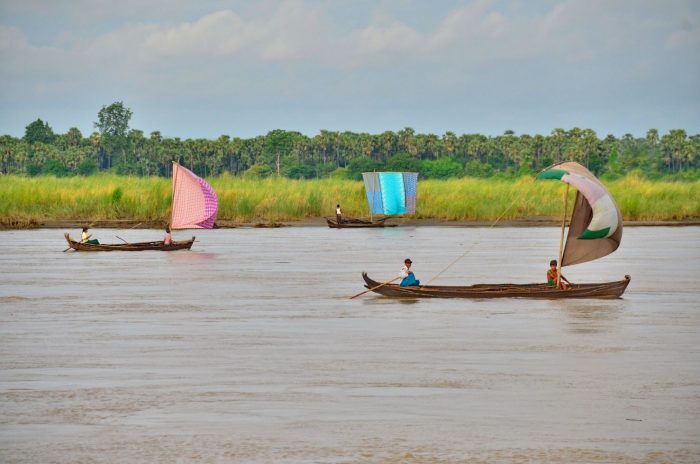
We finish the day with sunset at U Pein, a mile-long Burmese teak bridge that’s popular with both tourists and villagers walking across Lake Taungthaman. As the sun finally settles into the water everything goes still; there is a hush across the landscape, the boatmen’s yells subside, children are hushed by their mothers, and silence blankets the lake. It’s a magical experience.
Early the next morning we make our way to the village of Shwe Kyet Yet to offer alms to the monks of the local temple. Belmond and the Road to Mandalay have a long history in the village and finance one of the local nursery schools. As day breaks over the village, roadside cafes bustle with men drinking strong coffee with condensed milk and watching football highlights, while in the markets, stallholders prepare for another day’s trading.
READ: How About a New Wellness Hotspot in the Maldives?
The monks file up in order of importance, and the line of crimson-robed holy men soon snakes down the dirt road towards the river. Tiny, inquisitive faces peer at us from the end of the line; the youngest must come last, but there is plenty to eat and they leave with their black alms bowls filled with more than enough rice. Anything the monks can’t eat will be passed on to the believers who call the temple home. Nothing is wasted.
We spend the afternoon on Sagaing, a holy mountain across the river from Shwe Kyet Yet encrusted with over 600 temples and monasteries. After climbing to the highest point to visit the Soon U Ponya Shin Pagoda and to revel in the spectacular views down to the Inwa Bridge and the Irrawaddy River, we visit the Zeyar Theingi Nunnery, another beneficiary of the Road to Mandalay’s charitable efforts. Here, young nuns dressed in delicate pink robes chant scripture by heart in preparation for an examination. Strangers are still rare and groups of girls leave their studies to watch us shyly from the upper windows.
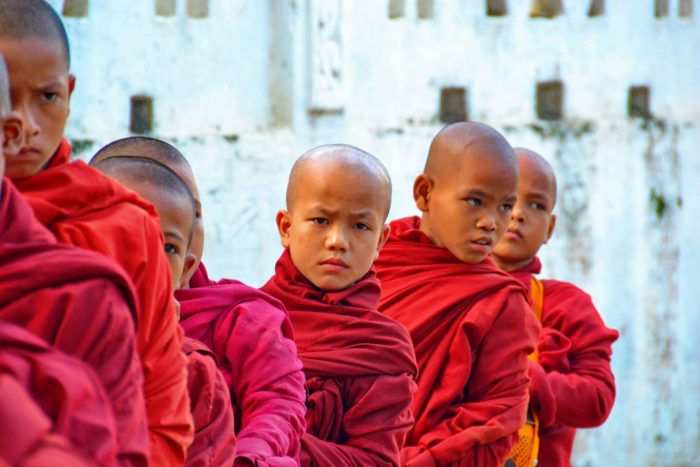
Evening falls and guests on the ship make the most of their last night aboard as the sun sets behind the temple tops. In the waters below, fishermen cast their nets wide by hand, still curious about this beautiful ship and its foreign passengers. Burma is on the cusp of a new chapter, and with any hope, tourists and sustainable tourism operators won’t be a novelty for too much longer.
For more Cruising inspiration click here.
Want to Stay Up to Date? Follow us on Facebook or Instagram or Sign Up for our Bi-Weekly Newsletter.

